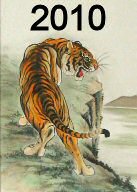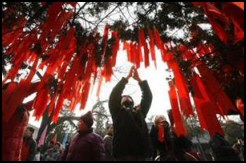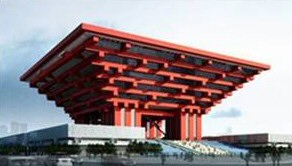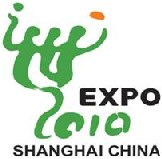The Chinese New Year 2010 Begins on February 14th.
- What Chinese
New Year Animal for 2010? - Calculating
‘What is Chinese New Year Animal’ - Chinese New Year with Associated 12 Animals
- Chinese New Year Jokes
- Chinese New Year Stories
- Shanghai, China
2010: World Expo - Wishing Tree For New
Year 2010
What Chinese New Year
Animal for
2010? 庚寅
2010 is the Chinese year of the Tiger. Specifically, this is the
year of Gēng-yín
庚寅 (Metal Tiger). Here is a list of animals which
answer the question: What Chinese New Year?
Rat Ox Tiger
Rabbit Dragon Snake Horse Sheep Monkey Rooster Dog Pig
2008
2009 2010
2011
2012 2013 2014
2015 2016 2017 2018
2007
Calculating ‘What
is Chinese New Year Animal’
The fact that the date of Chinese New Year varies within about a month
is a clue that it’s linked to the new moon. A rough, guide is that the Chinese New Year falls on the second new moon after the shortest day. The winter solstice always falls
on December 21st,
the next new moon is January 15th, and the second new moon February
14th 2010.
The Chinese New Year Calendar
– With
Its Associated 12 Animals
The lunar Chinese New Year (CNY) calendar below shows which of 12 animals you are! Naturally the
animal depends on the year in which you were born. Note: if you were born in January or February you need to check if
your birthday was before or after the date of that Chinese New Year. (If it was
before this day your animal is the one shown for the previous year).
|
|
|
|
|
|
|
|
|
|
|
|
1925 |
1937 |
1949 |
1961 |
1973 |
1985 |
1997 |
2009 |
|
|
|
|
|
|
|
|
|
|
|
|
1927 |
1939 |
1951 |
1963 |
1975 |
1987 |
1999 |
2011 |
|
|
|
|
|
|
|
|
|
|
|
|
1929 |
1941 |
1953 |
1965 |
1977 |
1989 |
2001 |
2013 |
|
|
|
|
|
|
|
|
|
|
|
|
1931 |
1943 |
1955 |
1967 |
1979 |
1991 |
2003 |
2015 |
|
|
|
|
|
|
|
|
|
|
|
|
1933 |
1945 |
1957 |
1969 |
1981 |
1993 |
2005 |
2017 |
|
|
|
|
|
|
|
|
|
|
|
|
1935 |
1947 |
1959 |
1971 |
1983 |
1995 |
2007 |
2019 |
60 Year Cycle of the Chinese New Year Calendar
Unlike western calendars, the Chinese calendar has names that are repeated
every 60 years. Within the ‘Stem-Branch’ system is shorter ‘Celestial’
cycle of 12 years denoted by animals. Furthermore, the Chinese believe
that people born in a particular year take on the characteristics of the animal
associated with that year.
Rat Ox
Tiger
Rabbit Dragon Snake Horse Sheep Monkey Rooster Dog Pig
2008
2009 2010 2011
2012
2013 2014
2015 2016 2017 2018
2007
Another dimension of the Chinese zodiac is the 5 ‘Terrestrial’ elements of metal, water, wood,
fire and earth.
If the year ends in 0 it is Yang Metal.
If the year ends in 1 it is Yin
Metal.
If the year ends in 2 it is Yang Water.
If the year ends in 3 it
is Yin Water.
If the year ends in 4 it is Yang Wood.
If the year ends in
5 it is Yin Wood.
If the year ends in 6 it is Yang Fire.
If the year
ends in 7 it is Yin Fire.
If the year ends in 8 it is Yang Earth.
If the year ends in 9 it is Yin Earth.
Start date for the Chinese New Year Calendar 2013 and following years
The lunar Chinese New Years dates are:
2013 – Feb 10; 2014 – Jan 31; 2015 –
Feb 19; 2016 Feb 8th; 2017; Jan 28th.
See more on the Chinese New
Year
Wishing Tree For Chinese New Year 2010
A man ties his New Year wish to a “wishing tree” at the White
Cloud Temple, Beijing, on the day of Chinese New Year. See image
to the right.
A child in traditional costume takes part in the Chinese
New Year celebrations at the Dongyue temple, Beijing, China. The
Lunar New Year is be marked with a week-long holiday.
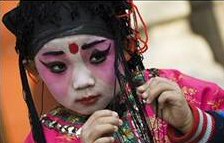
Chinese New Year Masks
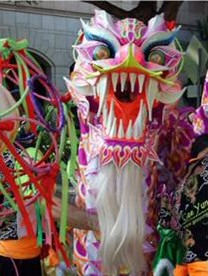
Masks in Chinese culture are part and parcel of the world culture of
masks……. 面具 Mianju. Masks first appeared in China during the Shang dynasty
over 3,500 years ago. The colourful and exciting celebrations for the
Chinese New Year last for many days, and end with the famous lantern
festival.
See more on Chinese New
Year masks.
Examples of Chinese Script
The development of Chinese characters can be dated back to about
4,500 years as discovered at Yanghe, Shandong Province in recent years.
There are about a dozen pottery wine vessels unearthed, which have a
character each. Those characters are quite close to the oracle
inscriptions carved by the ancients of the Shang Dynasty [16th to 11th
century B. C.].
Here is the Chinese name for Guy Thomas

Here below is the Chinese name for William Baker

English Words
Borrowed from Chinese
Words taken completely or in part from another language are known as
loanwords. In the English language, there are many loanwords that have
been borrowed from Chinese languages and dialects. Here are ten
common English words that are borrowed from Chinese.
- Coolie: While some claim that this term has its
origins in Hindi, it’s been argued that it could also have origins
in the Chinese term for hard work or 苦力 (kǔ lì) which is literally
translated as “bitter labour.” - Gung Ho: The term has its
origins in the Chinese word 工合 (gōng hé) that can either mean to
work together, or as an adjective to describe someone that is overly
excited or too enthusiastic. The term gong he is a shortened word
for industrial cooperatives which were created in China in the
1930s. During that time U.S. Marines adopted the term to mean
someone with a can-do attitude. - Chop Chop: This term is said
to originate from the Cantonese dialect for the word 快快 (kuài kuài)
which is said to urge someone to hurry up. Kuai means hurry in
Chinese. “Chop Chop” appeared in English-language newspapers printed
in China by foreign settlers as early as the 1800s.
- See more English words borrowed from Chinese
Shanghai, China 2010: World Expo

World Expositions are galleries of human inspirations and thoughts.
Since the Great Exhibition of 1851 was held at Crystal Palace, London,
the World Expositions have attained increasing prominence as grand
events for economic, scientific, technological and cultural exchanges,
serving as an important platform for displaying historical experience,
exchanging innovative ideas, demonstrating esprit de corps and looking
to the future.
The picture to the right is an Artist’s impression of the China Pavilion
Expo2010 will take place in Shanghai, China. Will and Guy would like
to share with readers what can be expected at this 2010 exposition.
- It will take place in Shanghai, China.
- While the Chinese New Year in 2010 begins on February 14th, the Expo starts on 1st May 2010 and
runs until 31st October
2010. - 100 million visitors are expected to attend.
- There are already 194 participants signed up to display their
exhibits - theme of Expo 2010 is “Better City, Better Life,”
representing the common wish of the whole humankind for a better
living in future urban environments. - This emblem, depicts the image of three people: you, me,
him/her holding hands together, symbolizing the big family of
mankind. - See here the Marvellous pavilions which have been, and are being built.
We are pleased to report that they will use solar energy. - Watch the
promotional Expo
2010 video here - Created from a Chinese character meaning people, the mascot “Haibao”
embodies the character of Chinese culture. See the lovely
Haibao character below.
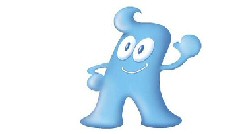
Footnote:
Please write to Will and Guy if you have any
information about ‘What is Chinese New Year’.
See More About the Chinese New Year Calendar, also Jokes and
Funny Stories:
• Chinese New Year 2014 •
Chinese Day October 1st •
Chinese New Year jokes •
What New Year
• Chinese New Year 2015 •
Interesting Chinese facts •
Chinese traditional foods •
Chinese food
♥ Chinese Valentine’s Day •
Chinese Moon Festival Zhongqiujie •
Chinese New Year Lantern Festival
